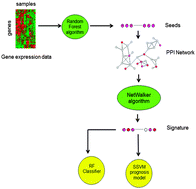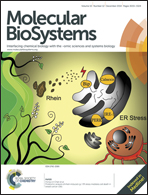Network-based sub-network signatures unveil the potential for acute myeloid leukemia therapy†
Abstract
Although gene expression profiling studies of acute myeloid leukemia (AML) patients have provided key insights into potential diagnostic and prognostic markers and therapeutic targets, it is not clear that the patterns of molecular heterogeneity affect the tumor biology and respond to the treatment. We hypothesized that network-based gene expression signatures of AML represent the mechanistically important genes and may improve the predicted performance of prognosis and clinical outcome. We provided the random walk with restart (RWR) analysis to discover the sub-network of genomic alterations. The RWR approach integrates the signature genes derived from the random forest (RF) analysis as “seeds” to identify genes critical to the AML recurrence phenotype. To test whether the 81-gene biomarkers could predict AML recurrence, we developed Survival Support Vector Machine (SSVM) models using a gene expression dataset and test on an independent dataset. The random forest classifier was built based on 81-gene biomarkers to separate the AML patients into “recurrence” and “non-recurrence” groups. The 81-gene biomarkers showed significant enrichment related to cancer pathophysiology and provided good coverage of sub-network biomarkers and AML-related signaling pathways. The SSVM-based score was significantly associated with overall survival (hazard ratio [HR], 2.16; 95% confidence interval [CI], 1.18–3.97; p = 0.01). Similar results were obtained with reversed training and testing datasets (hazard ratio [HR], 1.6; 95% confidence interval [CI], 1.08–2.37; p = 0.02). The 81-gene biomarker based RF classifier improved classification performance. Overall, 81-gene biomarkers might be useful prognostic and predictive molecular markers to predict the clinical outcome of AML patients.


 Please wait while we load your content...
Please wait while we load your content...